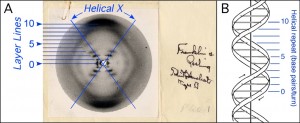Contribution in modern age
The main contribution of X-ray crystallography is that it enabled scientist to have better understanding of atomic and molecular structures. Certain fields in science, especially chemistry, biology, and material science, had taken advantage of this technique and quickly developed their knowledge further. In material sciences, many inorganic and organometallic materials were analyzed using X-ray crystallography. It is known that more than 500,000 structures were solved by X-ray crystallography.
- In the field of chemistry
In the field of chemistry, development of X-ray crystallography made huge impact on chemists’ understandings of chemical bonds. Starting from the typical radii of atoms, many theoretical models of chemical bonding are revealed and confirmed using X-ray crystallography. Furthermore, use of X-ray crystallography enabled chemists to find more different types of chemical bonds, such as metal-metal double bonds and metal-metal quadruple bonds. There are many other contributions that X-ray crystallography had made in the field of chemistry, such as discovering more detailed characteristics of hydrogen bonds and taking a large role in the early form of molecular replacement and super-molecular chemistry.
- In the field of biology
The contribution of X-ray crystallography in the field of biology is also remarkable. With the development of X-ray crystallography technique, the structures of many organic compounds were solved. Starting with simple structures such as long-chain fatty acids, which are an important component of biological membranes, more and more complex molecule structures were solved. Within several decades, many major molecule structures, including cholesterol, penicillin, vitamin B12, and insulin, were solved by X-ray crystallography. After biologists solved many simple molecule structures, they started solving more complex molecules such as proteins. After the first solved crystal structure of sperm whale myoglobin, more than 86,000 crystal structures of proteins were solved until now. In recent days, X-ray crystallography is used to determine how a pharmaceutical drug interacts with its protein target.
- In the field of material science
In material sciences, many complicated inorganic and organometallic systems have been analyzed such as fullerenes, metalloporphyrins, and other complicated compounds. X-ray crystallography is also used in the pharmaceutical industry because of the problems with polymorphs. The crystal’s size and regularity is the major factors that affects the quality of single-crystal structure. The Cambridge Structural Database contains over 500,000 structure and over 99 percent of them were determined by X-ray diffraction.


